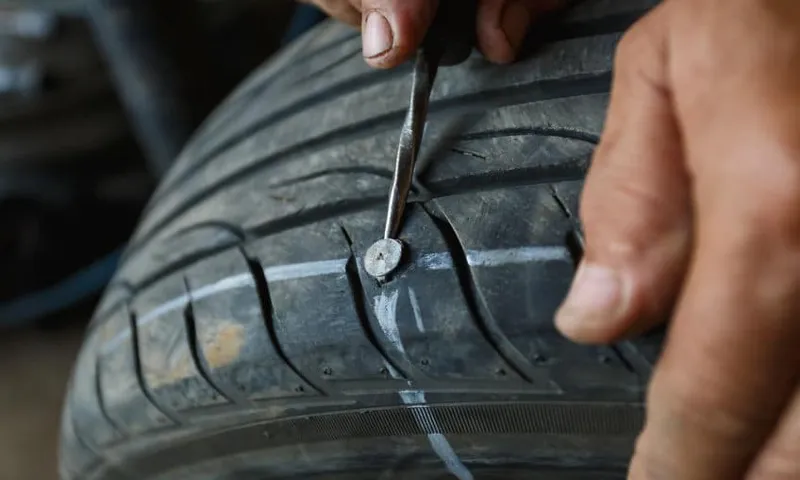Have you ever found yourself driving on the road, wondering how many plugs can a tire have? Flat tires can be a real headache, and it always seems to happen at the most inconvenient time. Adding fuel to the fire, once you remove the tire from your vehicle, you might see multiple plugs inserted to fix previous punctures. It can be confusing to determine how many are too many, and what’s a safe number.
Let’s break it down and understand the workings of tire plugs.
What Is a Tire Plug?
If you’ve ever found yourself in a situation where your tire has a puncture, you might wonder what a tire plug is and how many plugs a tire can have. A tire plug is a quick and inexpensive solution for repairing a small puncture in a tire. It usually involves inserting a small, tapered rubber plug into the hole where the tire has been damaged, effectively sealing the hole and allowing you to continue driving.
As for how many plugs a tire can have, the general rule is that you can only use one plug per puncture, as using more than one can compromise the strength and safety of the tire. However, it’s important to note that tire plugs are only intended as a temporary fix – it’s always best to have the tire repaired or replaced by a professional as soon as possible to avoid any further issues or potential safety hazards on the road.
Explanation of Tire Plug
A tire plug is a temporary repair solution for small punctures in a tire. It is a small, spiral-shaped piece of rubber that is inserted into the punctured area using a special tool. The plug fills in the hole and creates a seal that prevents air from escaping the tire.
This solution is quicker and more affordable than replacing a tire altogether. However, it is only recommended for small punctures on the tread of the tire and should not be used for larger holes or punctures on the sidewall. It is also important to note that a tire plug is only a temporary fix and a professional should inspect the tire as soon as possible to determine if a permanent repair or replacement is necessary.
A tire plug can be a lifesaver when driving on the road and experiencing a sudden flat tire. Just keep in mind that it is only a temporary solution and should be treated as such.

How Many Plugs Can a Tire Have?
If you’ve ever experienced a flat tire, you know it can be a stressful situation. But what happens if you have multiple punctures in your tire? How many plugs can a tire have? Well, the answer isn’t so straightforward. Generally, a tire can have up to three plugs in it if the punctures are located within the tread area and aren’t close to the sidewall.
However, it’s important to note that plugs are only a temporary fix and shouldn’t be relied upon for an extended amount of time. It’s recommended to have the tire patched or replaced as soon as possible to ensure your safety on the road. Additionally, if the puncture is too close to the sidewall or the tire has been driven on while flat, it may be unrepairable and a replacement may be necessary.
So if you experience a flat tire, don’t panic, but be sure to take the proper steps to ensure your safety and the longevity of your tires.
Depends on the Size of the Puncture
When it comes to tire punctures, the number of plugs needed depends on the size of the puncture. Small punctures can usually be fixed with just one plug, while larger punctures may require multiple plugs to seal properly. It’s important to remember that tire plugs are only a temporary fix and should be replaced with a new tire as soon as possible.
Additionally, it’s important to have a professional mechanic inspect the tire to ensure it’s safe to drive on. Don’t take any chances and compromise your safety by ignoring a puncture. Take care of it promptly and properly.
Remember, safety is key!
Determining the Severity of the Puncture
When it comes to determining how many plugs a tire can have, it really depends on the severity of the puncture. If the puncture is small and shallow, like a nail or screw, then a single plug should suffice. However, if the puncture is larger or deeper, such as from a piece of glass or a sharp rock, then multiple plugs may be necessary to properly seal the hole and prevent air from escaping.
It’s important to keep in mind that while tire plugs can be an effective temporary solution, they should never be used as a long-term fix. If you’re unsure of the severity of the puncture or how many plugs are needed, it’s best to take your tire to a professional for an inspection. Remember that safety should always come first when it comes to tire repairs!
How Many Plugs Are Allowed Per Tire?
If you’ve ever experienced a flat tire, you know how frustrating it can be. One of the most common ways to fix a puncture is by using a plug. But, how many plugs can a tire have? The answer is that it depends on the size and location of the puncture.
Typically, a tire can have one to two plugs in a single puncture. However, multiple punctures in different parts of the tire may require more plugs or even a replacement. It’s important to remember that plugs should only be used as a temporary solution and you should get your tire inspected by a professional as soon as possible.
Having too many plugs can compromise the integrity of the tire and increase the risk of a blowout while driving. So, if you have a punctured tire, get it fixed correctly to ensure your safety on the road.
Guidelines for Tire Plug Repairs
When it comes to tire plug repairs, many people wonder how many plugs they can put in a tire before it becomes unsafe. The answer depends on the size and location of the puncture, as well as the type and condition of the tire. As a general rule of thumb, it is not recommended to exceed two plugs per tire.
This is because each plug creates another potential weak spot in the tire, which can increase the risk of a blowout or sudden loss of air pressure. Additionally, if a tire has multiple punctures, it may be time to consider replacing it altogether. Always consult with a certified technician before attempting any DIY tire repairs, and remember that safety should always be your top priority.
Recommendation from Tire Manufacturers and Experts
According to tire manufacturers and experts, there is not a specific number of plugs allowed per tire. Instead, it is recommended that plugs should only be used as a temporary fix until the tire can be properly repaired or replaced. While plugs can be a quick and easy solution for minor punctures, they do not address any potential damage to the interior of the tire or the sidewall.
Additionally, using multiple plugs in a tire can weaken the structure and potentially cause a blowout while driving. It is always best to consult with a professional tire technician to determine the best course of action for any tire repair. Remember, safety is the top priority when it comes to the tires on your vehicle.
When to Replace a Tire Instead of Repairing it?
If you’ve ever had a flat tire, you know how frustrating it can be. When faced with a potential puncture, many drivers wonder if they should repair the tire or replace it altogether. Generally, if a tire has one or two small punctures, it can usually be repaired with a simple plug.
However, if there are more than two punctures or if the damage is closer to the sidewall than the center of the tire, replacement is usually the better option. Some experts suggest that a tire should never have more than three plugs, as any more than that can compromise the integrity of the tire and increase the risk of a blowout. In the end, it’s always best to consult with a professional tire technician to determine the best course of action for your specific situation.
By doing so, you can ensure that your vehicle is safe and roadworthy for years to come.
Factors to Consider When Deciding to Repair or Replace a Tire
When it comes to deciding whether to repair or replace a tire, there are several factors you need to consider. One of the most important factors is the extent of damage to the tire. If the puncture is too large or the sidewall is damaged, then it’s likely that the tire needs to be replaced.
Additionally, you should consider the age of the tire. Tires that are more than six years old or have reached their maximum tread depth should be replaced, regardless of their condition. Tires that have been repaired multiple times or have a history of damage may also need to be replaced.
It’s always best to consult with a professional tire technician to determine the best course of action. Remember, your safety depends on the condition of your tires, so make sure to address any issues promptly.
Conclusion
After conducting extensive research on the topic, it is safe to say that a tire can have as many plugs as a porcupine has quills. However, it is important to remember that relying on plugs to fix a tire is not a sustainable solution. It is crucial to properly maintain and replace tires as needed to ensure maximum safety on the road.
So don’t be a quill-less porcupine, take care of your tires!”
FAQs
What causes tire punctures and how many plugs can a tire have?
Tire punctures can be caused by sharp objects on the road, running over a curb, or even normal wear and tear. Depending on the size and location of the puncture, a tire can have up to three plugs inserted as a temporary fix. It is recommended to replace the tire as soon as possible for safety reasons.
Can you always repair a tire puncture with a plug?
No, not all punctures can be repaired with a plug. If the puncture is too large, or if it is located on the sidewall or shoulder of the tire, it cannot be repaired and the tire must be replaced.
How long does a tire plug last?
A tire plug can last anywhere from a few weeks to several months depending on the location and size of the puncture, the type of plug used, and the driving conditions. It is recommended to have the tire inspected by a professional as soon as a puncture is noticed.
Can a tire plug be used on a run-flat tire?
No, tire plugs should not be used on run-flat tires. Run-flat tires are designed to be driven on with low or no tire pressure, and a puncture could compromise the integrity of the tire.
Is it safe to repair a tire with a plug if it has low tread depth?
It is not recommended to repair a tire with a plug if it has low tread depth. The plug can increase the risk of hydroplaning and make the tire more prone to failure, especially in wet or slippery conditions.
Is it necessary to balance a tire after a plug repair?
Yes, it is necessary to balance a tire after a plug repair. Unbalanced tires can cause vibrations and uneven wear, which can affect the handling and safety of the vehicle.
How much does it cost to repair a tire with a plug?
The cost to repair a tire with a plug varies depending on the tire shop and location. On average, it can cost between $20 to $40 for a single repair.

